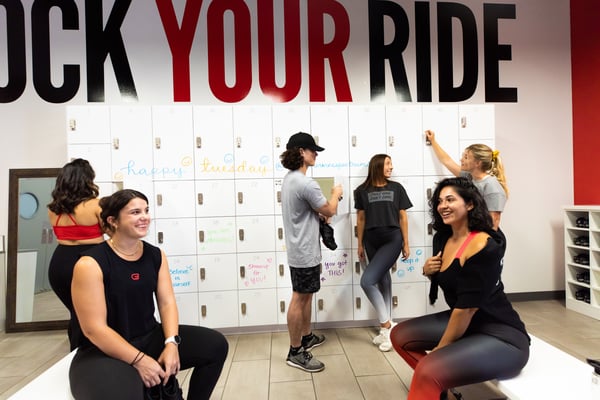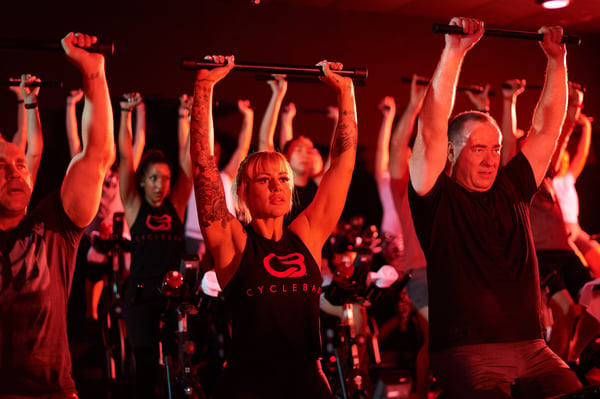Cycling is a fantastic way to stay fit and healthy, whether you prefer outdoor rides or indoor spin classes. It offers a low-impact, but effective workout that strengthens your heart, tones your muscles, and improves your overall endurance.
However, like any form of exercise, cycling comes with its fair share of potential injuries. From knee pain to saddle sores, these common cycling injuries can be both painful and demotivating. To ensure that your cycling experience remains enjoyable and injury-free, it's essential to understand how to spin smart.
In this post, we discuss everything you need to know about common cycling injuries, mistakes to avoid and ways you can prevent future occurrences.
A Brief Look At The Benefits Of Cycling
Don’t let the risk of injuries scare you away. Indoor cycling is an excellent fitness option, offering a wide range of benefits that make it ideal for all ages, body types, and skill levels.
One of the standout features of indoor cycling is that it provides a low-impact, high-intensity workout. This means it’s gentle on your joints while still offering a challenging heart-pumping workout.
Indoor cycling is also a fantastic way to get fit and stay in shape. The high-intensity intervals boost your heart rate, improve your heart health, and strengthen your leg muscles. Regular sessions can also improve your endurance, making everyday activities easier and more enjoyable.
If weight loss is your goal, indoor cycling is also an effective solution. A single session can burn hundreds of calories and boost your metabolism, making it a highly efficient way to support your weight loss journey.
Beyond the physical benefits, indoor cycling also improves mental well-being. The endorphins released during exercise help reduce stress, anxiety, and depression and the structured environment of a spin class combined with motivating music can provide a mental escape, leaving you feeling refreshed and energised after each session.
Read More: 7 Benefits Of Cycle Classes To Get You Started
Common Cycling Injuries & Prevention
While indoor cycling is exhilarating and beneficial, it can sometimes lead to injuries, especially if proper precautions are not taken. Here are some common injuries and effective strategies to prevent them:
Cycling And Lower Back Pain
One of the most frequent complaints among cyclists is lower back pain. This discomfort often arises because cyclists typically develop strong leg muscles without always developing sufficient torso strength to support the force generated by their legs. When the back muscles have to compensate excessively, it can lead to spasms, fatigue, and discomfort.
- Maintain Proper Posture: Get into the habit of keeping your back straight both when standing and while riding. This helps distribute the workload evenly and reduces strain on the lower back.
- Core Strengthening: Incorporate core-strengthening exercises into your routine to provide better support for your back muscles during cycling.
Cycling and Numb Toes
Numbness or "burning feet" during or after cycling is often caused by nerves being compressed due to tight cycling shoes or excessive pressure on the feet.
- Proper Shoe Fit: Ensure your cycling shoes fit correctly and are not too tight. Adjust straps or cleats if necessary to relieve pressure on the nerves.
- Check Footwear: Remove any irregular seams, straps, or buckles from your shoes that may be pressing against your foot and causing discomfort.
Cycling and Hand Injuries
Hand injuries, such as tingling or numbness in the palm or fingers, are another common issue among cyclists, particularly during longer rides.
- Grip and Hand Position: Maintain a firm yet relaxed grip on the handlebars. Change hand positions frequently to reduce constant pressure on specific areas.
- Wrist Alignment: Keep your wrists straight rather than bent excessively. This helps to minimize stress on the wrists and hands.
- Use Padded Gloves: Consider using padded cycling gloves or handlebar tape to reduce vibration and provide additional cushioning.
Cycling and Shoulder Pain
Shoulder pain can develop during longer rides due to placing too much weight on the hands and riding with straight elbows.
- Elbow Flexion: Keep your elbows slightly bent ("soft elbows") rather than locked straight. This posture helps to absorb shock and reduce strain on the shoulders.
- Core Engagement: Engage your core muscles to support your upper body and reduce reliance on the handlebars for balance.
Cycling and Knee Injuries
Knee injuries are some of the most common issues cyclists encounter, often due to overuse. Improper bike fit is another reason for knee pain and discomfort.
- Gradual Training: Avoid sudden increases in intensity or duration. Gradually build up your riding distance and speed to allow your muscles and joints to adapt.
- Proper Bike Fit: Ensure your bike is properly fitted, especially the saddle height. Your knee should have a slight bend when the pedal is at its lowest position. If you're unsure about bike fit, our trainers at Cycle Bar can help you determine the appropriate height for your saddle.
What Are Saddle Sores?
During cycling and spinning, prolonged contact with the bike saddle can lead to skin lesions known as saddle sores. There are 4 common types of saddle sores that can impact your riding experience, including:
- Chafing: Chafing occurs when friction from skin or thighs rubbing against the bike seat causes redness and irritation. It's often the beginning stage of saddle sores.
- Ulcerations: Ulcerations occur when the top layer of skin wears off due to persistent chafing, making it susceptible to bacterial infection.
- Furuncles: Furuncles, also known as boils, can develop around hair follicles due to bacterial infection. They are painful and can worsen with continued cycling and no treatment.
- Folliculitis: Folliculitis occurs when hair follicles become inflamed or infected, resembling small pimples. It is often caused by friction and sweat buildup.
Treating Saddle Sores
Dealing with saddle sores can be uncomfortable, but with proper care, you can find relief and promote healing effectively so you can get back in the studio in no time!
- Take a Break from Cycling: To allow the affected skin to heal, it's recommended to stay off your bike for at least a couple of days. Continuous friction and pressure can aggravate saddle sores and delay recovery.
- Keep the Area Clean and Dry: Clean the affected area gently with mild soap and water to remove sweat, dirt, and bacteria. Pat dry with a soft towel to avoid further irritation.
- Prevention of Infection: Keeping the area dry reduces the risk of bacterial growth and infection, which can complicate the healing process.
- Topical Treatments: Apply over-the-counter topical ointments or creams recommended for treating skin irritation or minor wounds. These products can help soothe discomfort and promote healing.
- Warm Compress: Applying a warm, moist compress to the affected area can alleviate pain and inflammation.
Tips To Prevent Saddle Sores
To help prevent saddle sores from ruining the fun of your indoor cycling session, consider these tips:
- Choose the Right Saddle: Select a saddle that matches your body type and cycling style. More padding doesn't always equate to more comfort; instead, focus on finding a saddle that supports your sit bones.
- Reduce Friction: Apply a quality chamois cream to areas prone to friction. This helps reduce the risk of chafing and saddle sores.
- Choose Cycling Shorts or Bibs Wisely: Opt for cycling shorts or bibs that are seamless to minimize friction against the skin.
- Maintain Cleanliness: After cycling, change out of your cycling shorts as soon as possible. Taking a shower soon after your ride helps cleanse the skin of sweat and bacteria, reducing the likelihood of skin irritations and infections.
.jpg?width=6579&height=4386&name=IMG_3965_FINAL%20(1).jpg)
Common Cycling Mistakes To Avoid
While injury can’t always be prevented, adopting proper cycling practices and techniques significantly reduces the risk. These include:
- No Warmup: Skipping a warmup before cycling can lead to muscle stiffness and an increased risk of injury. Incorporate a brief warmup routine that includes dynamic stretches and light cycling to prepare your muscles and joints for the ride ahead.
- Incorrect Saddle Position: Riding with a saddle that is too high, too low, or improperly positioned can cause discomfort, inefficiency in pedalling, and eventually, injury. Be sure to adjust saddle height, tilt, and position according to your body and riding style.
- Neglecting Your Core: A weak core can lead to poor posture, decreased power output, and increased strain on other muscles. Incorporate core-strengthening exercises into your fitness routine to improve stability, endurance, and overall cycling performance.
- Avoiding Proper Recovery: Failing to prioritise recovery can lead to overtraining, fatigue, and decreased performance over time. Don’t forget to rest after your ride and hydrate properly. Additionally, incorporating rest days or active recovery activities into your training plan can help build strength and reduce injury.
- Don’t Overdo It: Pushing yourself too hard, too soon, or increasing intensity abruptly can lead to overuse injuries and burnout. Instead, gradually increase your training load, listen to your body's signals, and incorporate periods of easy or recovery rides into your training schedule.
- Not Wearing the Right Gear: Ill-fitting cycling shoes or inadequate cycling apparel can cause discomfort, and blisters, and affect your overall performance. If it is something you plan to incorporate regularly, invest in proper cycling gear, including well-fitted shoes, padded shorts and moisture-wicking clothing to enhance comfort and performance.
Read More: Post-Spin Class Recovery: Techniques To Soothe Tired Muscles
When To See A Professional For Your Injury?
Knowing when to seek professional medical help for a cycling-related injury is crucial for effective treatment and recovery. Here are key indicators that it's time to consult a healthcare professional:
- Persistent Pain: If you experience persistent pain that doesn't improve with rest or basic home remedies, it's essential to get a professional evaluation. This includes pain in joints, muscles, or any area that significantly impacts your ability to cycle or perform daily activities.
- Swelling or Inflammation: Swelling, redness, or visible inflammation around the injury could indicate a more serious issue such as a strain, sprain, or even a fracture.
- Limited Range of Motion: If you find it difficult to move a joint or limb normally, or are experiencing stiffness that persists beyond a few days, it may indicate a more complex injury that requires medical attention.
- Numbness or Tingling: Persistent numbness, tingling, or loss of sensation in any part of your body, especially in the hands, feet, or limbs, requires a professional medical evaluation to rule out nerve damage or compression.
- Difficulty Bearing Weight: If you have difficulty holding weight on a limb or joint, it could indicate a more severe injury such as a fracture or ligament tear.
- Recurrent Injuries: If you have a history of recurrent cycling injuries or if injuries are becoming more frequent, a professional check-up can help identify underlying causes.
- Professional Guidance for Recovery: Seeking professional help can provide you with a tailored recovery plan, including physical therapy exercises, rehabilitation procedures, and advice on when it's safe to resume cycling and other fitness activities.
.jpg?width=8181&height=5454&name=493_CYCLEBAR-SUBI_220523_DC25849%20(1).jpg)
Experience Safe and Comfortable Cycling
Cycling is not just a workout; it's a lifestyle that promotes fitness, confidence, and personal challenges. From proper bike fit and equipment selection to maintaining good posture and listening to your body, every decision you make on the bike contributes to your overall comfort and longevity as a cyclist!
Are you passionate about cycling and eager to improve your skills while enjoying a supportive community? Join us at Cycle Bar where we offer state-of-the-art indoor cycling facilities across Australia and expert-led classes tailored to all fitness levels. Whether you're a beginner or a seasoned cyclist, our studio provides a welcoming environment to achieve your fitness goals and enhance your cycling experience.
Contact us today to book your first session and discover the benefits of indoor cycling firsthand. Let's ride towards fitness together!

.jpg?width=7988&height=5325&name=483_CYCLEBAR-SUBI_220523_DC11809%20(1).jpg)
.jpg?width=5568&height=3712&name=136_CYCLEBAR_210531_C5A0608%20(1).jpg)


